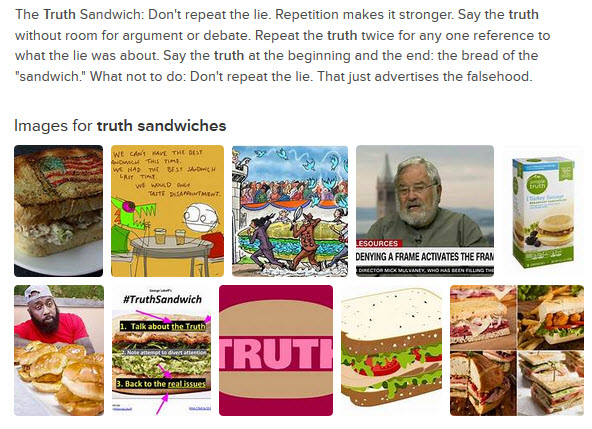File:What is a 'Truth Sandwich'.jpg
What_is_a_'Truth_Sandwich'.jpg (592 × 429 pixels, file size: 117 KB, MIME type: image/jpeg)
Can You Handle the Truth?
It's 'Truth Sandwich' Time
The Problem:
Disinformation and misinformation, lies and untruths, conspiracy theories (without evidence or provable facts), a time of chaos and disbelief as rumors and rumor-mongering spreads like an online wildfire across the internet, across computer screens, across national and international borders. Lies, lies and more lies as a way of waging cyber- and political-war.
Clearly, we need a better way.
The Challenge:
We, interconnected digital citizens, need new ways to handle the reality and unreality of information being presented to us everyday and every hour over every digital and human-mediated channel. How do we deal with the bots, the trolls, the brazen liers and the deceived, the trending memes and gifs full of falsehoods...
One answer is in the form of --- wait for it -- 'truth sandwiches'.
A Recipe:
Here's how to make a truth sandwich, presented by different chefs in the kitchen.
No credits to the chefs and their quotes, just a primer on what is a truth sandwich and how to go about making them when you need to serve them up.
The Truth Sandwich: Don't repeat the lie. Repetition makes it stronger. Say the truth without room for argument or debate. Repeat the truth twice for any one reference to what the lie was about. Say the truth at the beginning and the end: the bread of the "sandwich." What not to do: Don't repeat the lie. That just advertises the falsehood.
The idea is to start with the truth, then state the claim, and follow that with more reality.
Skipping the first step and just putting the falsehood first and then debunking it, linguist George Lakoff told CNN and the Post, may reinforce it in the minds of audience members. Starting with the truth, then reporting the claim and then adding more fact-checking, helps avoid that problem.
Re: Responding to dis/misinformation, w/ facts and debunking
Yes, it takes a scale of magnitude much larger than that used by those who create the dis/misinfo and those who spread it and amplify it online
And, in responding to and correcting the mis/disinfo/conspiracy theories, the mis/disinfo conspiracy claims are spread online in the process of factual correction. The fact-finding orgs have been working on ways to deal w/ this for yrs, eg ‘truth sandwiches’...
Poynter has done some good work in creating a global fact-finding network, but an unseen battle is going on every day.
Check out PolitiFact - https://www.politifact.com/ - and the International Fact-Checking Network - https://www.poynter.org/ifcn/, they are taking the battle between facts and falsehood to the trenches...
How to serve up a tasty ‘truth sandwich?’
Important people tell lies. Journalists seek to expose those lies and the bad intentions behind them. The exposure of a lie can spread the lie. Do I ignore the lie and hope it does not become poison in the body politic? Do I report it, check it against the facts, and leave it to the public to render judgment?
Or is there another way?
... a Twitter sequence that cites New York University professor Jay Rosen, PBS reporter Yamiche Alcindor, retired UC Berkeley professor of linguistics George Lakoff, CNN chief media correspondent Brian Stelter, and Washington Post media columnist Margaret Sullivan.
The proposed antidote to political lying even has a name now, which I first heard during a conversation on
“Reliable Sources,” Stelter’s CNN show. Call it the “truth sandwich.”
It derives from the work of Lakoff, an expert on strategic language and the framing of civic arguments. His proposed formula, summarized on Twitter, goes like this:
Truth Sandwich:
Start with the truth. The first frame gets the advantage.
Indicate the lie. Avoid amplifying the specific language if possible.
Return to the truth. Always repeat truths more than lies.
How to Fight Disinformation With a 'Truth Sandwich ...
In the 1997 movie "Liar, Liar," Jim Carrey plays Fletcher Reede, a highly successful lawyer with a propensity for compulsive lying. He suddenly finds himself unable to tell anything but the truth, the whole truth, so help him … well, you know the rest.
I just built a truth sandwich – Truth on top, the deception in the middle, and the truth repeated at the end.
Journalism professor and media critic Jay Rosen has been pushing hard on the truth sandwich concept:
State what is true.
Report that a false or dubious claim has been made. (But only if it’s newsworthy, meaning important for the public to know it happened. Otherwise use silence.)
Repeat what the actual truth is.
That’s the truth sandwich — reality, spin, reality — all in one tasty, democracy-nourishing meal.
Avoid retelling the lies. Avoid putting them in headlines, leads or tweets, he says. Because it is that very amplification that gives them power.
That’s how propaganda works on the brain: through repetition, even when part of that repetition is fact-checking.
Truth Sandwich, by George Lakoff:
Truth Sandwich:
1. Start with the truth. The first frame gets the advantage.
2. Indicate the lie. Avoid amplifying the lie if possible.
3. Return to the truth. Always repeat truths more than lies.
~
File history
Click on a date/time to view the file as it appeared at that time.
| Date/Time | Thumbnail | Dimensions | User | Comment | |
|---|---|---|---|---|---|
| current | 19:26, 12 November 2020 |  | 592 × 429 (117 KB) | Siterunner (talk | contribs) |
You cannot overwrite this file.
